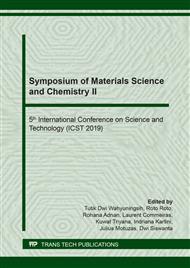[1]
Z. Arifin, S. Pratapa, Triwikantoro, Darminto, Analysis of CaCO3 products from lime solution, AIP Conf. Proc. 90 (2013) 1554-1590.
DOI: 10.1063/1.4820291
Google Scholar
[2]
J.I. Foley, Use of mineral trioxide aggregate (MTA) by postgraduates in restorative dentistry in the UK, Eur. J. Prosthodont. Restor. Dent. 19 (2011) 179-183.
Google Scholar
[3]
K.S. Min, S.H. Yang, E.C. Kim, The combined effect of mineral trioxide aggregate and enamel matrix derivative on odontoblastic differentiation in human dental pulp cells, J. Endod. 35 (2009) 847-850.
DOI: 10.1016/j.joen.2009.03.014
Google Scholar
[4]
M. Torabinejad, D.J. White, U.S.A. Patent 5415547 (1995).
Google Scholar
[5]
K. Al-Hezaimi, J. Naghshbandi, S. Oglesby, J.H.S. Simon, I. Rotstein, Comparison of antifungal activity of white coloured and gray coloured MTA at similar concentrations against candida albicans, J. Endod. 32 (2006) 365-367.
DOI: 10.1016/j.joen.2005.08.014
Google Scholar
[6]
S. Asgary, M. Parirokh, M.J. Eghbal, F. Brink, Chemical differences between white and gray mineral trioxide aggregate, J. Endod. 31 (2005) 101-103.
DOI: 10.1097/01.don.0000133156.85164.b2
Google Scholar
[7]
J.W. Ahn, J.H. Kim, H.S. Park, J.A. Kim, C. Han, H. Kim, Synthesis single phase aragonite precipitated calcium carbonate in Ca(OH)2-Na2CO3-NaOH reaction system, Korean J. Chem. Eng. 22 (2005) 852-856.
DOI: 10.1007/bf02705664
Google Scholar
[8]
K. Prasad, D.V. Pinjari, A.B. Pandit, S.T. Mhaske, Phase transformation of nanostructured titanium dioxide from anatase to rutile via combined ultrasound assisted sol-gel technique, Ultrason. Sonochem. 17 (2010) 409-415.
DOI: 10.1016/j.ultsonch.2009.09.003
Google Scholar
[9]
M. Neumann, M. Epple, Monohydrocalcite and its relationship to hydrated amorphous calcium carbonate in biominerals, Eur. J. Inorg. Chem. 14 (2007) 1953-1957.
DOI: 10.1002/ejic.200601033
Google Scholar
[10]
M. Aziz, Kalsium karbonat karakteristik serta penggunaannya, Makalah Teknik 3 (1997).
Google Scholar
[11]
Y. Guven, E.B. Tuna, M.E. Dincol, O. Aktoren, X-ray diffraction analysis of MTA-plus MTA-angelus and diaroot bioaggregate, Eur. J. Dent. 8 (2014) 211-215.
DOI: 10.4103/2278-344x.130603
Google Scholar
[12]
A. Meiszterics, L. Rosta, H. Peterlik, J. Rohonczy, S. Kubuki, P. Henits, K. Sinko, Structural characterization of gel-derived calcium silicate systems, J. Phys. Chem. A 114 (2010) 10403-10411.
DOI: 10.1021/jp1053502
Google Scholar
[13]
G. Voicu, A. I. Bădănoiu, C.D. Ghiţulică, E. Andronescu, Sol-gel synthesis of white mineral trioxide aggregate with potential use as biocement, Dig. J. Nanomater. Biostruct. 7 (2012) 1639-1646.
Google Scholar
[14]
F. Belnou, J. Bernard, D. Houivet, J.M. Haussonne, Low temperature sintering of MgTiO3 with bismuth oxide based additions, J. Eur. Ceram. Soc. 25 (2005) 2785–2789.
DOI: 10.1016/j.jeurceramsoc.2005.03.140
Google Scholar
[15]
Q. Li, N.J. Coleman, The hydration chemistry of proroot MTA, Dent. Mater. J. 34 (2015) 458-465.
DOI: 10.4012/dmj.2014-309
Google Scholar
[16]
I. Islam, H.K. Chng, A.U.J. Yap, Comparison of the physical and mechanical properties of MTA and portland cement, J. Endod. 32 (2006) 193-197.
DOI: 10.1016/j.joen.2005.10.043
Google Scholar
[17]
W.N. Ha, T. Nicholson, B. Kahler, L.J. Walsh, Methodologies for measuring the setting times of mineral trioxide aggregate and portland cement products used in dentistry, Acta Biomater. Odontol. Scand. 2 (2016) 25-30.
DOI: 10.3109/23337931.2015.1135746
Google Scholar
[18]
W.N. Ha, D.P. Bentz, B. Kahler, L.J. Walsh, The strongest contributor to setting time in mineral trioxide aggregate and portland cement, J. Endod. 41 (2015) 1146-1150.
DOI: 10.1016/j.joen.2015.02.033
Google Scholar
[19]
T. Komabayashi, L.S.W. Spangberd, Comparative analysis of the particle size and shape of commercially available mineral trioxide aggregates and portland cement: a study with a flow particle image analyzer, J. Endod. 34 (2008) 94-98.
DOI: 10.1016/j.joen.2007.10.013
Google Scholar


